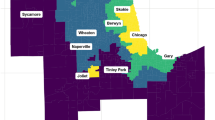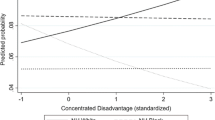Abstract
Homicide is one of the leading causes of death among African-American and Hispanic men. We investigated how neighborhood characteristics associated with social disadvantage explain racial/ethnic homicide gaps in 10 U.S. cities. The test hypotheses were that (1) higher concentrations of African-Americans and Hispanics would be associated with higher homicide rates and (2) the relationship between racial/ethnic concentration and homicide would be attenuated after adjusting for neighborhood characteristics (e.g., unemployment, median household income, low educational attainment, and female headship). The test hypotheses were examined using separate Poisson regression models, which adjusted for spatial autocorrelation. Homicide rates were greater in neighborhoods with higher concentrations of African-Americans and Hispanics than in other groups, and the association of neighborhood racial/ethnic concentration with homicide was reduced after adjusting for neighborhood social disadvantage variables, especially percent female head of household and percent persons with less than a high school education. We also found that the relationship between neighborhood racial/ethnic concentration and homicide was explained more by social disadvantage variables in some cities than in others. Based on our findings, policy makers may wish to consider implementation of policies that (1) expand early childhood education programs and higher education opportunities and (2) encourage economic and community development initiatives in socially disadvantaged neighborhoods.



Similar content being viewed by others
References
Centers for Disease Control and Prevention. WISQARS Non-fatal Injury Reports. 2004. http://cdc.gov/ncipc/wisqars/. Accessed on October 5, 2007.
Zernike K. Violent crime in cities shows sharp surge. New York Times. March 8, 2007. http://wwwnytimes.com/2007/03/09/us/09crime.html. Accessed on October 12, 2007.
Reiss AJ, Roth JA, eds. Understanding and preventing violence. Panel on the Understanding and Control of Violent Behavior, Committee on Law and Justice, Commission on Behavioral and Social Sciences and Education, National Research Council. Washington, DC: National Academies; 1993.
Sampson RJ, Wilson WJ. Race, crime, and urban inequality. In: Hagan J, Peterson RD, eds. Crime and Inequality. Stanford, CA: Stanford University Press; 1995:37–54.
Wilson WJ. The Truly Disadvantaged: The Inner City, the Underclass, and Public Policy. Chicago, IL: University of Chicago Press; 1987.
Sampson RJ. Urban black violence: the effect of male joblessness and family disruption. Am J Sociol. 1987;93:349–382.
Sampson RJ, Groves BW. Community structure and crime: testing social disorganization theory. Am J Sociol. 1989;94:774–802.
Galea S, Ahern J. Distribution of education and population health: an ecological analysis of New York City neighborhoods. Am J Public Health. 2005;95:2198–2205.
Gjelsvik A, Zierler S, Blume J. Homicide risk across race and class: a small-area analysis in Massachusetts and Rhode Island. J Urban Health. 2004;81(4):702–718.
Krueger PM, Bond Huie SA, Rogers RG, Hummer RA. Neighbourhoods and homicide mortality: an analysis of race/ethnic differences. J Epidemiol Community Health. 2004;58:223–230.
Krivo LJ, Peterson RD. Extremely disadvantaged neighborhoods and urban crime. Soc Forces. 1996;75(2):619–650.
Phillips JA. Variation in African-American homicide rates: an assessment of potential explanations. Criminology. 1997;35(4):527–560.
Phillips JA. White, black, and Latino homicide rates: why the difference. Soc Probl. 2002;49(3):349–373.
Cubbin C, LeClere FB, Smith GS. Socioeconomic status and injury mortality: individual and neighborhood determinants. J Epidemiol Community Health. 2000;54:517–524.
Huie SA, Hummer RA, Rogers RG. Individual and contextual risks of death among race and ethnic groups in the United States. J Health Soc Behav. 2002;43:359–381.
Jones-Webb R, McKee P, Hannan P, Wall M, Pham P, Erickson D, Wagenaar A. Alcohol and malt liquor availability and promotion and homicide in inner cities. Subst Use Misuse. 2008;43:159–177.
Bureau of Census. Census’90 Basics. Washington, DC: Government Printing Office; 1990.
Kreiger N. Overcoming the absence of socioeconomic data in medical records: validation and application of census-based methodology. Am J Public Health. 1992;82:703–710.
Krieger N, Chen JT, Waterman PD, Soobader M, Subramanian SV, Carson R. Geocoding and monitoring of the US socioeconomic inequalities in mortality and cancer incidence: does the choice of area-based measure and geographic level matter. Am J Epidemiol. 2002;156:471–482.
Parker RN, Rebhun LA. Alcohol and Homicide: A Deadly Combination of Two American Traditions. Albany: State University of New York; 1995.
Levitt S. Using electoral cycles in police hiring to estimate the effect of police on crime. Am Econ Rev. 1997;87(3):270–290.
Marvell T, Moody C. Specification problems, police levels and crime rate. Criminology. 1996;34(4):609–646.
Gruenewald PJ, Remer L. Changes in outlet densities affect violence rates. Alcohol Clin Exp Res. 2006;30:1184–1193.
Draper NR, Guttman I. Incorporating overlap effects from neighbouring units into response surface models. Appl Stat. 1980;29:128–134.
Haining R. Spatial Data Analysis in the Social and Environmental Sciences. UK: Cambridge University Press; 1990.
Strom KJ, MacDonald JM. The influence of social and economic disadvantage on racial patterns in youth homicide over time. Homicide Stud. 2007;11(1):50–69.
Wallace JM, LaViest TA. Health risk and inequitable distribution of liquor stores in African-American neighborhoods. Soc Sci Med. 2000;51:613–617.
Cameron SV, Heckman JJ. The dynamics of educational attainment for black, Hispanic, and white males. J Polit Econ. 2001;109(3):455–499.
Wojtkiewicz RA, Donato KM. Hispanic educational attainment: the effects of family background and nativity. Soc Forces. 1995;74(2):559–574.
US Census Bureau, Educational Attainment in the United States: 2005. US Census Bureau, Population Division, Education & Social Stratification Branch. September 7, 2006.
Cohen DA, Mason K, Bedinmo A, Scribner R, Basolo V, Farley T. Neighborhood physical conditions and health. Am J Public Health. 2003;93:467–471.
Bowles S, Gintis H, Osborne M. The determinants of earnings: a behavioral approach. J Econ Lit. 2001;39(4):1137–1176.
Heckman JJ, Stixrud J, Urzua S. The effects of cognitive and noncognitive abilities on labor market outcomes and social behavior. J Labor Econ. 2006;24:411–482.
Huston H, Anglin D, Eckstein M. Drive-by shootings by violent street gangs in Los Angeles: a five year review from 1989 to 1993. Acad Emerg Med. 1996;3:300–303.
Song D, Naude G, Gilmore D, Bogard F. Gang warfare: the medical repercussions. J Trauma. 1996;40:810–815.
Winkleby MA, Cubbin C. Influence of individual and neighborhood and socioeconomic status on mortality among Black, Mexican-American, and White women and men n the United States. J Epidemiol Community Health. 2003;57:444–452.
Reynolds AJ, Temple JA, Robertson DL, Mann EA. Long-term effects of an early childhood intervention on educational achievement and juvenile arrest: a 15 year follow-up of low-income children in public schools. JAMA. 2001;5:2339–2346.
Reynolds AJ, Temple JA, Robertson DL, Mann EA. Age 21 cost–benefit analysis of the Title I Chicago child–parent center program. Executive summary. June 2001. Available at: http://search.msn.com/results.aspx?q=Age+21+cost-benefit+analysis+of+the+Title+I+Chicago+child-parent+center+program&FORM=MSNH.
GAO-06-727. Report to Congressional Committees, United States Government Accountability Office. Empowerment zone and enterprise community program: improvements occurred in communities, but the effect of the program is unclear. September 2006;1–39.
Marin Institute. Community organizing action pack. http://marininstitute.org/action_packs/community_org.htm. Accessed on November 5, 2007.
Acknowledgements
This study (R01 AA13839) was funded by the National Institute on Alcohol Abuse and Alcoholism, Rhonda Jones-Webb, Principal Investigator.
Author information
Authors and Affiliations
Corresponding author
Rights and permissions
About this article
Cite this article
Jones-Webb, R., Wall, M. Neighborhood Racial/Ethnic Concentration, Social Disadvantage, and Homicide Risk: An Ecological Analysis of 10 U.S. Cities. J Urban Health 85, 662–676 (2008). https://doi.org/10.1007/s11524-008-9302-y
Received:
Accepted:
Published:
Issue Date:
DOI: https://doi.org/10.1007/s11524-008-9302-y




